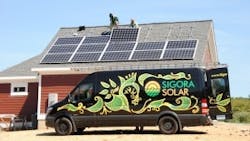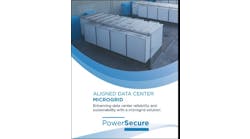Credit: LEAP
The solar and energy efficiency industries often are seen as brethren in the clean energy cause. But in truth, they are competitors. Energy efficiency undercuts solar profits. The more efficient a home or building, the fewer solar panels it needs.
As a result, it’s difficult to get solar installers to abide by the oft-stated recommendation that they make sure the home is as energy efficient as possible before they size the solar energy system.
I recently wrote an article about a solution proposed in California, which was to make solar a subset of state energy efficiency programs. (See Would Homeowners Say “Yes” to Energy Efficiency if it Came with Solar?) The model would capitalize on solar’s popularity to help spur more energy efficiency. I didn’t realize at the time that my home town of Charlottesville, Virginia, already was doing just that.
How Solarize Works
Solarize Charlottesville is one of the many solarize programs springing up nationally that reduce solar costs for local homes and businesses through economies of scale. Begun in Portland, Oregon, solarize programs engage in collective negotiations with select installers who are willing to offer a group discount for a limited time within a community.
Like microgrids and solar gardens, solarize programs dovetail with the growing local energy movement. Cities, states, neighborhood groups and non-profit organizations are among those that launch solarize programs. (See this partial list of solarize programs. )
Is there a solarize program in your community? Tell us how it works by joining the discussion on our LinkedIn Group, Energy Efficiency Markets.
What makes Solarize Charlottesville particularly interesting? The program was begun by a non-profit organization that has spent years making local homes and businesses more efficient in central and northern Virginia. The Local Energy Alliance Program (LEAP) has walked the talk by promoting rather unsexy energy efficiency measures, like insulation and lighting, before moving into the popular solar energy arena. The group waited until solar pricing looked right.
Since the second quarter of 2010, solar prices have dropped 61 percent, according to a report published by the Solar Energy Industries Association/GTM Research. The low prices are spurring a tremendous level of solar adoption. Installations are expected to grow by 36 percent this year. Through the first half of the year, 53 percent of all new electric capacity installed in the US came from solar.
“LEAP has been doing energy efficiency in this community for a little over four years now. We have been following the renewable markets pretty closely. It wasn’t until this year that we looked at the prices of PV dropping and said, ‘Man it is time to do something,’” said Jon Proffitt, LEAP’s solar program manager.
Tremendous Response from Community
Solarize Charlottesville proved popular beyond LEAP’s imagining. In the three-month application period (July 1-Sept. 30), it received more than three times the applications expected. The two solar installers that LEAP selected for the program found themselves a bit “inundated” with more than 1,000 homeowners and businesses signing up, Proffitt said.
“During our launch event, I announced to everybody that we were hoping to get 300 homeowners signed up. I think two weeks later we had already reached that number. They just kept coming,” he said. “It wasn’t long before we were over 500 and were sending messages out to everybody letting them know we were going to be a bit slower than we originally thought, but we’d make sure we got to everyone and provided quality service.”
The good news is that LEAP was able to use the extra time to educate the applicants and begin energy savings improvements at several homes. As a value add, any solarize homeowner served by Dominion (the largest utility in the area) also could sign up for free home energy efficiency evaluation. More than half of the solarize applicants either had already undergone the LEAP evaluation or signed up to do so as part of the solar program. So for them energy efficiency came first, as it should given that it’s the cheapest, cleanest ‘fuel.’
“It’s really boosted our energy efficiency work. Several of the homeowners who have gone through our solarize program are working directly with LEAP to both reduce and produce, meaning they are doing a kind of whole house energy retrofit,” Proffitt said.
The solarize program is contributing to a larger goal LEAP has been pursuing; the nonprofit hopes to ‘build’ a virtual power plant for the area – create enough energy savings or distributed energy to avert the construction of a central power plant.
As Proffitt explains it, virtual power “is offsetting energy that would come from a potential future power plant, either by saving or by producing distributed clean energy. Either way still accomplishes pretty much the same goal. It all plays into the same idea of instead of having a central power plant – natural gas, nuclear, coal-fired plant somewhere – we have our own clean energy here in this community,” he said.
LEAP is offering Solarize Charlottesville in partnership with the City of Charlottesville, Albemarle County, and the UVA Community Credit Union. In early October, it also will launch a solarize program in Northern Virginia, beginning in Leesburg. In addition, the organization is in talks with other groups throughout the state about forming a Virginia-wide solarize program.
More information about Solarize Charlottesville, including pricing and financing details, can be found here. Separately, the Clean Energy States Alliance has published a guide on how to get a Solarize campaign started, which is available here.






